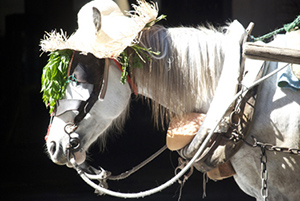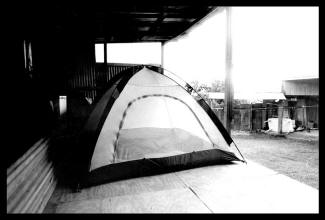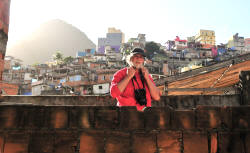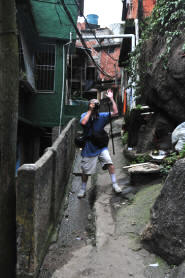Artist Statement
Gary Mark Smith is an established and highly regarded career street photographer who has excelled at his craft as a dedicated fine artist since 1978 and who is most satisfied having been a ground-breaker in his discipline in several respects. One of them being his ability to employ perilous access in his work (ignoring his rational voice and the accompanying fear to access the danger and anxiety and photographic drama inherent to extreme streets) to not only compose art amidst the fleeting street frenzy as all street photographers do, but to occasionally compose fine art street photography using world history and it’s extraordinary visual allure as an intellectually stimulating supporting character in his work.
Understanding Smith’s innovative contributions to the discipline of street photography begins with a reading of his original mission statement from the outset of his career:
Mission Statement. To create a compelling global street photography portfolio during one artist’s lifetime revealing both the variety of culture and similarity in character of urban elements and order that one encounters out on the seemingly chaotic streets of a single planet at the turn of a millennium where predominantly urban people can be studied and photographed in the wild going about the task of living out the commerce and leisure and bustle and sometimes grind of their everyday public lives.
– Gary Mark Smith, 1978
Pioneering in its discipline (and some say audacious in its commitment to access any street over an entire lifetime in a whole world on an artist’s budget), Smith’s mission statement and ensuing career of uncommonly whole and unhurried perspective has resulted in him becoming renowned as a master street photographer of unusual motivation, method and consequence. While intentionally escalating what had traditionally been a provincial art form into a worldwide one and dedicating himself to that end with an unwavering devotion to habitual art-priority travel, Smith has moreover veered off from the predictable norm of contemporary post-modern street photography by priding himself in the lengths he’ll go through to deliberately achieve literal composition in his work.
These photographic paintings (per se) largely employing stationary (still life) urban elements as place-defining supporting characters – which then rely on time and the predictable bustle of the city to provide the more post-modern inspired brushstrokes of serendipitous movement via coincidental human interaction within the still lifes – these images become portrayals of Smith’s frame of mind at that particular place in that particular time, typically ecstatic just being part of the flow of the everyday big city bustle and content using the city in his work (good or bad – in ordinary commerce or at the brink of war) pretty much as he’s found it.
“Nearly all these images are sympathetic toward their subjects, foregoing the aggressiveness and social satire of street photographer Garry Winogrand’s oeuvre. Whereas Winogrand remained an outsider on the street, Smith seems to resonate with the energy of the crowd, empathize with his subjects. The idea that the world is a stage (Theatrum mundi) has a long tradition. In 1858 a journalist, Victor Fournel, wrote a book titled “Ce qu’on voit dans les rues de Paris” (“What one sees on the streets of Paris”) employing the metaphor of the street-as-theater, Fournel declaimed: to stroll the sidewalks was to “take my seat in the pit of this improvised theater.” Gary Mark Smith has taken his place before the global stage of street life; with his camera in hand; he’s become an active bystander of the sorts originally played by the chorus in Greek drama. Smith speaks passionately about his fascination with street life, recalling poet Czeslaw Milosz’s comments after arriving in Paris after World War II: he spoke of his “joyous immersion in the reservoir of universal life… a swimmer who trusts himself to the wave, and senses the immensity of the element that surrounds him.”
– James R. Hugunin. Professor of Photo History & Contemporary Theory, School of the Art Institute of Chicago
Driven from his hiding place in Kansas by a puzzling wanderlust, Smith has (despite his reticence) become one of the most highly regarded street photographers of his time {Resume}. Since 1982 he has faithfully lived up to his global billing by executing several extensive street photography field expeditions per year (every year) out on the streets of more than 85 countries on six continents. Although most of these journeys focus on hunting down and capturing visually bold and intellectually stimulating candid moments at public gathering places (a people-watching bystander stalking the poetry of everyday life out on the streets) — Gary may best be known for photographing extraordinary and sometimes violent historical streets in their times.
Occasionally it’s during breakouts of war and peace, or breakouts of fierce natural calamity — or streets in times of revolutionary transition and disarray. But typically, when there is no history drawing him to its streets in it’s time, Gary wanders aimlessly around the globe in his own time. Hanging around at outdoor cafes or on streaming street corners or on park benches — willfully scouting for and anticipating moments of fleeting street art. Often camping out in his tent on location at city campgrounds or on favela rooftops to save money, thereby availing himself the lengths of time required abroad to accomplish his dedicated task.
*Gary’s camp on a covered outdoor music stage (called the Eric Clapton Stage because he’d played on it twice) at the Golden Arches Nightclub and Cafe inside the “Death Zone” during the Montserrat Volcano disaster in 1997. Three nights later at about 3:30am, an explosive eruption of the Soufriere Hills Volcano only three miles away rained hot pumas onto the corrugated metal stage roof and into the audience courtyard, but none hit the tent with the artist inside…
*Gary operating on the rooftops (where he slept at night) and in the narrow streets of the Rocinha Favela in Rio de Janeiro, Brazil in 2011 | photos by Sarah Stern.




